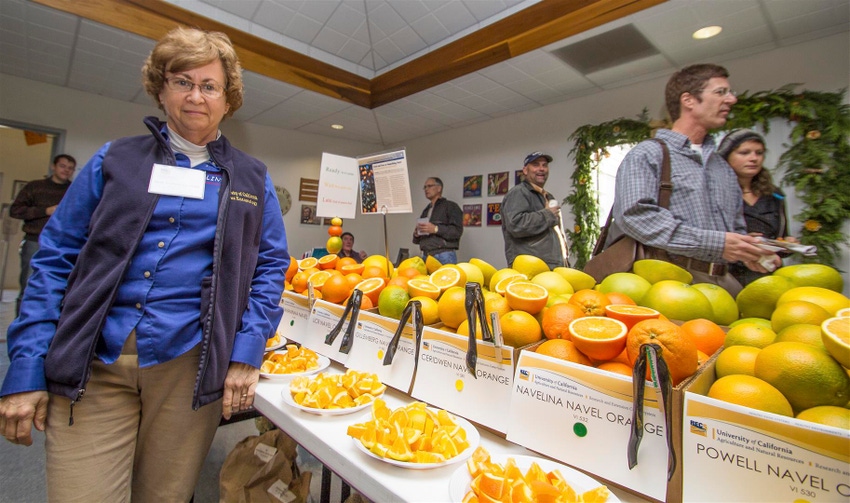
As if the epic drought wasn’t bad enough, one university researcher is saying pest issues in California citrus groves this year could be particularly bad.
University of California citrus research specialist Elizabeth Grafton-Cardwell studies pests at the Lindcove Research and Extension Center in Central California where she is also the station director. Grafton-Cardwell recently told growers that she expects a particularly tough year for mites and thrips.
“I’m not sure whether the freeze or the drought will be a major player, but watch your thrips populations,” Grafton-Cardwell said.
The Citrus Thrip is just one of several pests Grafton-Cardwell believes could be troublesome this year. While severe freeze damage will cause citrus leaves to fall to the ground – the leaves are where thrips overwinter as an egg – “drought conditions are when we see the highest populations of thrips,” she said.
“When we have wet years that seems to suppress the pupae from forming,” she continued.
On the other hand Bean Thrips, which live as adults inside Navel oranges, could be less of an issue this year because of the drought and the freeze. One likely reason is weed populations that harbor the Bean Thrip prior to moving into citrus was lower.
Grafton-Cardwell said researchers saw “some interesting situations in mandarins recently” related to the Western Flower Thrip. “We don’t normally think of it as a pest at all.” Because of the impacts of the freeze to mandarins, she said they saw Western Flower Thrips living between the fruit rind and doing some damage to the fruit.
“We don’t normally see that,” she said.
Grafton-Cardwell also expects mite populations – such as the Citrus Red Mite and the Two-Spotted Spider Mite – to be troublesome this year as the effects of the freeze and drought combine to make conditions ripe for the pest.
“Stressed trees have more mites,” she said.
Asian citrus psyllid
A relatively new invasive pest to the San Joaquin Valley citrus scene is the Asian citrus psyllid (ACP). It was discovered several years ago in Tulare County and has led to large quarantine zones in the county because of the deadly disease the pest vectors. Huanglongbing is a fatal tree disease that can manifest itself in leaf yellowing and the eventual death of the tree. Before the tree dies fruit is rendered bitter and unmarketable. Though no cases of the disease have been discovered in Tulare County some citrus industry officials fear it’s just a matter of time before it is discovered.
Grafton-Cardwell said she had hoped that the ACP would suffer from the freeze experienced in early December but those hopes were dashed when a single adult psyllid was discovered near Richgrove on a trap card put out after the freeze. This suggests that the freeze did little to knock down overwintering psyllid populations in the area.
Agronomic practices during the freeze, such as irrigation and wind machine use tend to create microclimates that the overwintering adult ACP populations can use to survive, she said. It’s generally only the nymph stages of the ACP that are likely harmed by freeze and adverse weather conditions. University research suggests that temperatures cold enough for long enough can have a lethal effect on psyllid populations, but those conditions are extremely rare in the San Joaquin Valley (SJV) of California.
Grafton-Cardwell expects psyllid discoveries in the SJV could be lower in the spring and greater in the fall. The pest is already well-established in southern California, where it was first discovered in 2008. Four years later one HLB-infected tree was discovered in a residential neighborhood in Los Angeles County.
Yet another possible impact of the freeze and drought in citrus groves could be the negative impacts to beneficial insects, Grafton-Cardwell said. These tend to suffer the greatest losses from such events, when compared to their invasive counterparts.
California Red Scale could also be particularly troublesome this year, as well as Citricola Scale, which she says she’s seen in some of her research blocks even after the freeze.
“Stressed trees have more scale,” she said.
Don't leave 'shiners'
Grafton-Cardwell stresses the importance of removing shiners – last year’s fruit – from the trees because they can harbor scale for next year’s fruit.
“Sometimes pickers leave them on the trees because they aren’t marketable,” Grafton-Cardwell said. “If you leave them on the tree they act as scale insectaries and provide lots of scales for the next year’s fruit. It’s best to get all the fruit off of the tree whether it is marketable or not.”
The Citrus Leafminer could be a significant issue in the fall, but not this spring, Grafton-Cardwell said. There was some good leafminer kill during the freeze as it tends to favor the new flush.
The Fuller Rose Beetle is one of the toughest insects on Earth, she said, and could likewise be an issue as chemicals and drought fail to control the insect.
Forktailed Bush Katydids could also be a problem as their eggs are “incredibly tough,” she said.
Grafton-Cardwell was asked about cutworms and leaf rollers because of issues seen in the Terra Bella area of Tulare County, Calif. She said researchers for years have not seen much of an issue in these pests because they’ve had good biological controls in the past.
Now with the advent of certain classes of Ag chemicals that have broad-spectrum control and can be used as a preventative measure against certain pests, Grafton-Cardwell has seen the natural enemies of secondary pests wiped out.
Virus slams 2013 California tomato yields
About the Author(s)
You May Also Like






